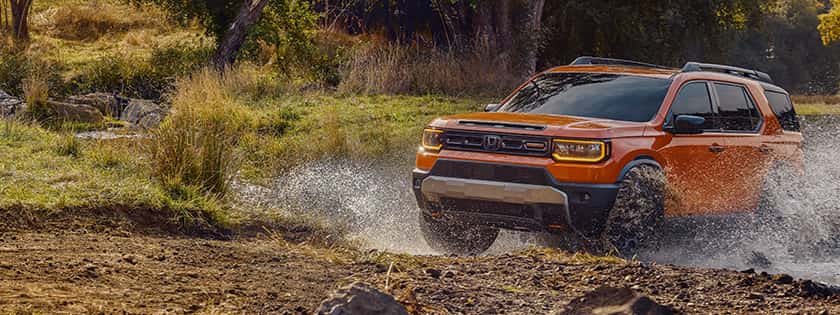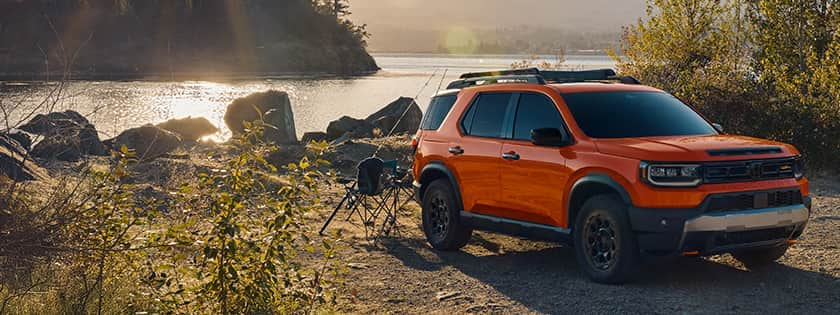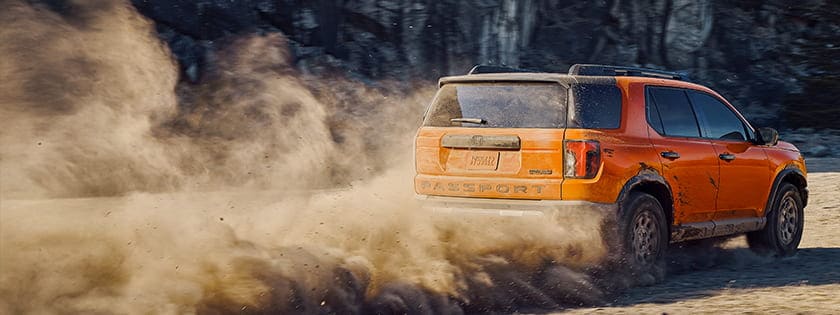The history of the Mazda 3 starts when it seemed Mazda would never build a car like it.
Mazda dribbled into the American market during 1970 with limited distribution in the states of Washington and Oregon. As the company expanded its American presence, it did so on the unique and compelling engineering of the Wankel rotary engine. But while the Wankel was powerful and smooth, it was also thirsty and ill-suited to the realities of commuting. By the mid-1970s it was apparent that Mazda was going to have to do something different.
By 1977 Mazda knew it had to make a piston-powered car the heart of its North American line. Or it was doomed.

1977-1980: First-Generation Mazda GLC
It looked like a contemporary hatchback in the mold of the front-drive Volkswagen Golf or Honda Civic, but the first "Great Little Car" was a primitive rear-driver with a solid rear axle: a Japanese Chevette.
"Someone had to be last," wrote Car and Driver's Don Sherman in a test of the GLC. "This time it's Mazda with the spanking new GLC do-everything MaxiMizer — because this is quite likely the last econocar built from the now obsolete front-engine, rear-drive blueprint. However, being last does offer one undeniable benefit — the chance to better all previous offerings — and Mazda has used this advantage well. The GLC is clearly the finest old-school minicar going."
It was what Mazda dealers needed: a cheap, showroom traffic builder. Initially available only as a three-door, it was priced at $2,945, with the Deluxe model at $3,245. Add in a five-speed transmission ($120) to replace the four-speed, an AM radio ($69) and 155mm section width Bridgestone radial tires and the total was still only $3,495.
But with 52 horsepower from its carbureted 1.3-liter SOHC engine on tap, it wasn't quick. Car and Driver measured it traipsing from zero to 60 mph in 15.1 seconds and trotting through the quarter-mile in 19.7 seconds at 66.8 mph.
During 1978, a five-door version was added to the line. A 65-hp, 1.4-liter engine went into the GLC for 1979, and that inspired a new Sport model. Plus a wagon joined the lineup. In 1980 there was a new nose with rectangular headlamps and some revisions to the interior. Mazda would continue selling versions of the "AP-series" rear-drive GLC wagon up through 1983.
The GLC did its job. In 1976, Mazda sold only 35,383 cars in the United States. During 1980, it sold 161,623.

1981-'85: Second-Generation Mazda GLC
Mazda's first front-drive car sold in America was as conservatively engineered as the rear-drive car it replaced. Transverse engine? Check. MacPherson strut front suspension? Of course. However, the new 1981 GLC did have an independent rear suspension.
Mazda's "BD" GLC's greatest asset was the new, lighter-weight Series E SOHC four-cylinder engine that displaced 1.5 liters and made 68 hp. It was matched to four- or five-speed manual transmissions or a three-speed automatic.
Also new to the second GLC was a four-door sedan-with-a-trunk body style that supplemented the never-popular five-door.
After a carryover year in 1982, in 1983 a "Sport" version of the five-door hatch joined the three-door. In 1984 the line was pared down to just the three-door hatch and four-door sedan. And 1985 was a rerun of '84.
Mazda sold 211,093 cars in the United States during 1985.

1986-'89: First-Generation Mazda 323
Offered, like the GLC, as a three-door hatchback or four-door sedan, the 323 was slightly larger and rode on a 1.4-inch-longer 94.5-inch wheelbase. It didn't even look much different from the GLC. But it was more refined and more substantially constructed.
The 323's new engine was the iron block, aluminum head, 1.6-liter SOHC eight-valve "B6." None of that was too startling. But the fact that this engine was fuel injected instead of carbureted was big news. And its 82 hp made it relatively speedy. Relatively.
"The 323LX 1.6i feels more Germanic than any other Japanese car we have driven," wrote Car and Driver's Larry Griffin in a road test of the five-speed sedan (a three-speed automatic was also available). "The five-speed is the best choice. It provides 28 mpg on the EPA city cycle and takes much of the howl out of high-speed cruising. It also makes the most out of the motor's muscles which flex you up to 60 in 10.5 seconds, raise a puff of dust in the quarter-mile traps in 17.4 seconds at 78 mph, and usher you up to a 106-mph top end."
A four-door station wagon joined the line for 1987, but it was the appearance of the all-wheel-drive, turbocharged 323 GTX in 1988 that was most exciting.
The turbo twincam version of the B6 engine was rated at 132 hp, and all that was fed through a lockable planetary center differential. But with a base price nearing $12,000, only 1,243 were sold during 1988 and 1989.

1990-'94: Second-Generation Mazda 323 and First-Generation Mazda Protegé
The 323 name continued on the three-door hatchback, but the 1990 "BG" generation of Mazda's small sedan became the Protegé in the United States. The 323 continued to use the 1.6-liter engine, while the Protegé got a new 1.8-liter SOHC four rated at 103 hp. The LX got a twincam 16-valve version rated at 125 hp.
While the GTX was dead, an all-wheel-drive version of the Protegé with the naturally aspirated DOHC was offered. It remained in the line through 1993.
The Protegé's wheelbase now stretched to 98.4 inches, but its engineering was still straightforward and simple. And Mazda's then-partner Ford based its American-market 1991 Escort on Mazda's BG chassis.

1995-'98: Second-Generation Mazda Protegé
The 323 name and hatchback body both disappeared with the arrival of the second-generation Protegé, which came only as a four-door sedan.
With a longer 102.6-inch wheelbase, the second Protegé was larger, and that paid off with 95.5 cubic feet of interior room. But the base engine actually got smaller with a 92-hp, 1.5-liter DOHC 16-valve engine in base DX and mainstream LX models. The SE's engine still displaced 1.8 liters and made 122 hp. Five-speed manual or four-speed automatic transmissions were available.
Front driver and passenger side airbags were now standard, but antilock brakes were a stout $800 option. The cheapest Protegé started at $11,995, with the most expensive at a chunky $16,145. The Protegé got a new front bumper and grille for 1997, and then played out the 1998 model year almost unchanged.

1999-2003: Third-Generation Mazda Protegé
The new "BJ" generation Protegé was a reinforced version of the previous car. "Engineered with Mazda's new 'Triple-H' construction, the Protegé pillars, roof rails and side sills get reinforced and gusseted frames," Edmunds wrote in a First Drive. "This will better protect occupants in the event of a side impact or rollover crash."
The one mechanical change was the growth of the base four used in the DX and LX from 1.5 to 1.6 liters and from 92 to 105 hp. The 1.8-liter version used in the line-topping ES was still rated at 122 hp. Transmission options didn't change.
In 2000, electronic brakeforce distribution was added to the optional ABS system. The big news for 2001 was the addition of the shockingly attractive Protegé 5 sport wagon variant.
Then there was the sport-oriented 2001 Protegé MP3 sedan. "The stock Protegé is a good performer in terms of handling, and the MP3 takes this dynamic to a higher level," we wrote in a comparison test. "Mazda recruited Racing Beat, an aftermarket tuning company that has supplied RX-7 enthusiasts with hop-up parts for years, to beef up this platform. The Protegé was lowered and fitted with Tokico shocks, higher-rate (read: stiffer) springs, larger stabilizer bars and a front strut-tower brace. Topping (or should we say bottoming?) it off are a set of 17-inch Racing Hart alloy wheels wearing 205/45ZR17 Dunlop tires. A quicker steering ratio sharpens up the response even more."
That handling was complemented with a 2.0-liter four rated at 140 hp. But it was a slight complement. "In a straight line, the MP3 got spanked by everything except the [Mitsubishi] Lancer," we reported. "The numbers: 9.0 seconds for the 0-60 sprint and 17.0 seconds for the quarter-mile."
While the MP3 didn't make it into 2002, 2003 brought with it the appearance of the turbocharged Mazdaspeed Protegé: the first Mazdaspeed-branded product offered for sale in America.
With an intercooled turbo system engineered by Callaway, the Mazdaspeed Protegé's 2.0-liter four was rated at 170 hp and fed that through a limited-slip differential. The result was a small piston-engine Mazda that could rip to 60 mph in less than 7 seconds.
The Protegé was at its end, though. And the next small Mazda would be something completely different.

2004-'09: First-Generation Mazda 3
With Mazda entwined in Ford's development process, the all-new 2004 Mazda 3 was based on Ford's excellent C1 platform: the same structure used under the European Ford Escort.
Offered as a four-door sedan or five-door hatchback, the first Mazda 3 was both bigger and sportier than any previous Mazda subcompact. "Mazda backs up the 3's sporty image with a pair of engines that places it at the top of the class when it comes to horsepower," wrote Edmunds' own Ed Hellwig. "The base sedan uses a 2.0-liter four-cylinder rated to produce 148 hp (144 in California), while the upgraded 's' models use a 2.3-liter four-cylinder that bumps the horsepower number to 160. Both engines can be equipped with either a five-speed manual or a four-speed automatic transmission."
A 2.3-liter Mazda 3 with the five-speed manual transmission sped to 60 mph in just 9.1 seconds in Edmunds' 2004 Mazda 3 road test, with the quarter-mile cruising by in 16.9 seconds at 83.7 mph.
The Mazda 3 seemed destined to become as noted for its comfort as for its size. Then came the 2007 Mazdaspeed 3.
Built around a turbocharged, direct-injected version of the 2.3-liter MZR engine rated at a dizzying 263 hp (more than five times the power of the 1977 GLC), the Mazdaspeed 3 was a rocket with a six-speed manual transmission and limited-slip differential.
With a fortified chassis, the hatchback Mazdaspeed 3 was one satisfying performance car. And quick. "At the drag strip, we recorded a 0-60 time of 5.9 seconds and a quarter-mile time of 14.2 seconds at 100 mph," wrote our Josh Jacquot. "That's 0.4 second slower to 60 than the last Subaru WRX we tested, but a staggering 1.3 seconds quicker to that speed than a 2006 Honda Civic Si. Plus, the Mazda is at an obvious launch disadvantage in the sprint to 60 against the WRX given the Subaru's all-wheel drive. By the end of the quarter-mile the Mazda's added power makes the contest a dead heat against the WRX and blows the Honda out of the water by almost a full second.... You won't find more punch for this kind of money in any other car, and that goes a long way in a class filled with capable contenders."
But by 2010, it was time for the next generation.

2010-'13: Second-Generation Mazda 3
Slightly longer and wider, the second Mazda 3 was again based on Ford's C1 architecture and still offered as a four-door or five-door and in either "i" versions powered by a 148-hp, 2.0-liter four or "s" models with a 2.5-liter four making 167 hp.
The Mazdaspeed 3 migrated over to the revised Mazda 3 almost entirely intact. But it was slower to 60, needing 6.4 seconds to hit the mark. "After scrutinizing the acceleration data for both cars, we see precisely where the differences lie," explained our Jason Kavanagh. "Both cars require two gearchanges to reach 60 mph, but where the old car's shifts are clean and quick, the new car exhibits a time-sapping wiggle after each gearchange. These wiggles are the result of some kind of built-in throttle manipulation intended to protect the drivetrain from shift shock or to smooth the gearchanges. Either way, they are responsible for making the new MS3 slower to 60 mph."
The 2014 Mazda 3 will have its work cut out to be as entertaining as the first two. Or all those GLCs, 323s and Protegés before it.

2014: Third-Generation Mazda 3
An all-new generation of the enthusiast-favorite hatchback and sedan will go on sale in fall of 2013, featuring the brand's Kodo design and a direct-injected Skyactiv four-cylinder gasoline engine.
Gone is the grinning front grille of the previous generation, replaced by a five-point grille and sharp style lines that cut into the side panels and surround the lights.
This new 2014 Mazda 3 is 1.6 inches wider and roomier than the model it replaces but is also lighter. Its wheelbase is 2 inches longer but the overall length of the car loses 1.8 inches.
Its 2.0-liter engine makes 155 horsepower and 150 pound-feet of torque, while the 2.5-liter makes 184 hp and 185 lb-ft of torque. A six-speed manual transmission is standard and an optional six-speed automatic is also available.
The 2014 Mazda 3 showcases new technology features not often found in the small-car class. Its infotainment system can now read short e-mail and SMS-based messages, as well as Twitter and Facebook updates. Safety equipment includes the new i-Activsense safety system which bundles warnings such as lane-departure and blind-spot monitoring.
The Mazda 3 is the brand's best-selling model, and with this redesign we expect that success to continue into 2014.




